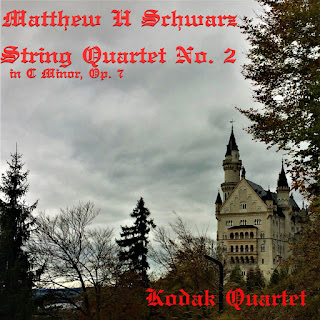Christina George - "The Last Words"
Christina George - The Last Words
The Last Words, while not literally programmatic, clearly and convincingly explores the multiple ways grief sounds to each and every one of us.
Christina George dubs her new piece, The Last Words, a 'break-up song' in three movements. Written for a subset of Radius Ensemble, clarinet, violin, double bass, and piano, George's music combines lyrical melodies, rhythmic grooves, and ambient thoughts, culminating in a profoundly emotional piece (watch the performance here).
The first movement "Remember how you left me" is in a short ternary form, begins with a propulsive groove in the piano and pizzicato bass. The intensely rhythmic drive grabs the audience's attention and allows the players to have fun with more intricate passagework in the violin and clarinet. George then opens up the space with high, sustained tones, only using slight pulses in the piano to tie the sections together rhythmically. With an explosion of sound, the opening material returns, but only for a brief moment. George reminds us of the melancholy nature of the piece by tying the sections together, and closing with a heart-wrenching violin solo.
After an uncomfortably long pause, well suiting the piece, "Clinging to" begins with an exposed piano solo reminiscent of an acoustic pop/punk song. George quickly turns into the new music world with sound effects, unmeasured ricochet in the strings and air noise on the clarinet, creating subtle interruptions in the ensemble. Throughout the movement, George does what she does best, slowly developing a hauntingly gorgeous melody by exploring space and timbre. The peak of the movement comes with a clarinet run played by Eran Egozy, showing off his control of the instrument.
Surprisingly, the final movement, "An empty kiss" is almost as long as the first two combined, and after listening, it feels as though it could function as its own piece. The flipping of traditional form allows for George to spend a longer time working through her material. She opens the movement with a minute-long piano solo, beginning with short, additive figures. This is quite a fun effect, but the rhythmically syncopated music does not come off as well as it could due to the amount of rubato added in the performance. While important that the piece flows, too much space added in the solo sections lose the sense of rhythm and George's purposeful offbeats. "An empty kiss" also allows George to show off her love of timbres. This movement is the first time we get a chance to hear a variety of sounds passed between all four instruments. Her use of snap pizzicato and artificial harmonics, while clearly difficult for the players, come across incredibly cohesively to the audience. She also makes the brave decision to cut out the piano during the last section of the movement. Doing so removes almost all percussive elements of the music, enabling the audience to focus solely of the remorseful sound of strained artificial harmonics in both strings, and sustained high tones in the clarinet.
The Last Words, while not literally programmatic, clearly and convincingly explores the multiple ways grief sounds to each and every one of us. Radius Ensemble gave an incredibly musical performance of George's work, playing and blending together beautifully. George's use of musical space, emotionally-moving melodies, and mastery of timbral awareness creates quite the rarity: a new work of contemporary classical music which demands attention from the audience.
Be sure to like, follow us, and comment your own thoughts!



Comments
Post a Comment